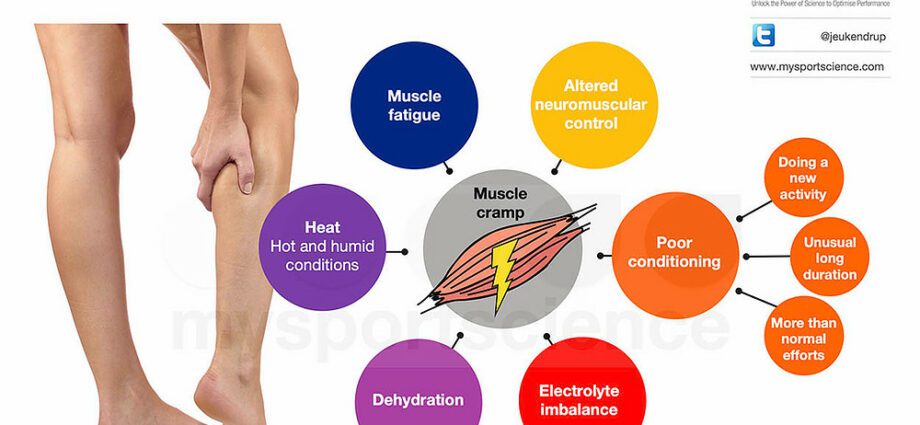Contents
Cramps
Cramps are musculoskeletal disorders manifested by involuntary, sustained, temporary muscle contractions and more or less painful, most often benign. They can occur at rest, including during sleep, or during fairly intense physical exertion, whether during warm-up, during exercise, or even during the recovery phase.
Mechanisms and symptoms of cramp
The origin of cramps is relatively complex and often results from several combined factors, whether vascular (disorder of blood circulation and insufficient muscular vascularization for a short time) or metabolic (excess production of lactic acid), dehydration, The cramp usually starts suddenly and suddenly, without any prior sign to anticipate it. It results in the involuntary and uncontrollable painful contraction of a muscle or a bundle of muscles resulting in temporary functional incapacity of the affected muscle group. She is of short time (from a few seconds to several minutes). In case of prolonged contraction, we speak of tetany. The muscles most often affected by cramps are those of the lower limbs, and in particular the calf.
Causes and types of cramps
There are several types of cramps, which vary according to their causes. They can be linked to a sporting effort, of metabolic origin or even result from different pathologies. The sports cramps are generally linked to intense effort, and occur in particular if physical preparation and muscle warm-up have been neglected. They can also result from excessive sweating or excessively intense muscular effort involving a sustained and prolonged contraction.
The metabolic cramps most often appear during dehydration, dyskalaemia (potassium deficiency) or insufficient vitamin B1, B5 or B6. There are other potential causes such as a lack of blood circulation in the muscle (linked for example to cold, which decreases vascularity).
Finally, the cramps can be related to other affections likely to cause them, such as the circulatory arterial disorders in the lower limbs (intermittent claudication), diabetes, multiple sclerosis, polio or even Parkinson’s disease.
Risk factors for cramps
Insufficient hydration, poor preparation for exercise, excessive effort, cold or abuse of coffee, alcohol and tobacco are, among others, potential risk factors. Cramps are also likely to appear more frequently in some people: pregnant women, the athletes or elderly are thus more concerned than the average.
Treatment and prevention of cramps
Except in cases where a pathology is responsible for the cramps, there is no miracle remedy to stop the cramps, which disappear on their own quite quickly. the temporary physical rest, by stopping the effort, and muscle stretching against the involuntary contraction, possibly associated with a muscle massage, remain the best ways to soothe these untimely contractions. Finally, it is possible to prevent the risk of cramps thanks to a physical warm-up adapted to the effort, a regular hydration before and during the effort, and a diet rich in salt, magnesium, potassium and vitamin B6.
Complementary approaches to cramps
Homeopathy
Take 3 granules of 9 CH, three times a day, of Magnesia phosphorica and Cuprum metallicum (which is also suitable for fighting stomach cramps).
- It is also possible to take Ruta graveolens at the same dosage.
- If the cramps are particularly painful, take Arnica montana.
- In case of nocturnal cramps, take Aesculus compound when it appears.
- To fight against finger cramps, opt for Argentum nitricum and Magnesia phosphorica in 7 CH.
aromatherapy
Certain essential oils are traditionally used to fight against cramps, in particular the essential oils of:
- Common oregano,
- Laurel noble,
- Fine lavender (Lavandula angustifolia)
- Common thyme thymol.
Other natural remedies
Other natural remedies are known to work against cramps.
- Tiger balm,
- trace elements and in particular magnesium associated with vitamin B6 and potassium,
- massages with vegetable oils,
- hot baths.
To find out more about cramps in the elderly, visit our article: www.passeportsante.net/fr/Actualites/Nouvelles/Fiche.aspx?doc=crampes-personnes-agees










